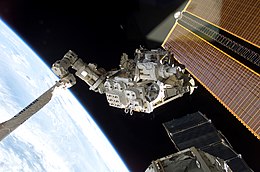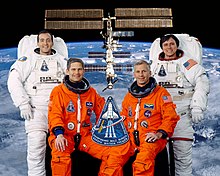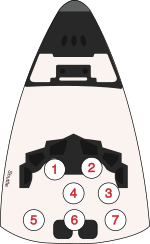 Canadarm2 grapples the Mobile Base System, prior to its installation on the ISS' Mobile Servicing System | |
| Names | Space Transportation System-111 |
|---|---|
| Mission type | ISS logistics Crew rotation |
| Operator | NASA |
| COSPAR ID | 2002-028A |
| SATCAT no. | 27440 |
| Mission duration | 13 days, 20 hours, 35 minutes, 56 seconds |
| Distance travelled | 9,300,000 kilometres (5,800,000 mi) |
| Spacecraft properties | |
| Spacecraft | Space Shuttle Endeavour |
| Launch mass | 116,523 kilograms (256,889 lb) |
| Landing mass | 99,385 kilograms (219,106 lb) |
| Payload mass | 12,058 kilograms (26,583 lb) |
| Crew | |
| Crew size | 7 |
| Members | |
| Launching | |
| Landing | |
| Start of mission | |
| Launch date | 5 June 2002 21:22:49 UTC |
| Launch site | Kennedy, LC-39A |
| End of mission | |
| Landing date | 19 June 2002 17:58:45 UTC |
| Landing site | Edwards, Runway 22 |
| Orbital parameters | |
| Reference system | Geocentric |
| Regime | Low Earth |
| Perigee altitude | 349 kilometres (217 mi) |
| Apogee altitude | 387 kilometres (240 mi) |
| Inclination | 51.6 degrees |
| Period | 91.9 minutes |
| Docking with ISS | |
| Docking port | PMA-2 (Destiny forward) |
| Docking date | 7 June 2002 16:25 UTC |
| Undocking date | 15 June 2002 14:32 UTC |
| Time docked | 7 days, 22 hours, 7 minutes |
  (L-R): Philippe Perrin, Paul S. Lockhart, Kenneth D. Cockrell, Franklin R. Chang-Diaz | |
STS-111 was a space shuttle mission to the International Space Station (ISS) flown by Space Shuttle Endeavour. STS-111 resupplied the station and replaced the Expedition 4 crew with the Expedition 5 crew. It was launched on 5 June 2002, from Kennedy Space Center, Florida.








